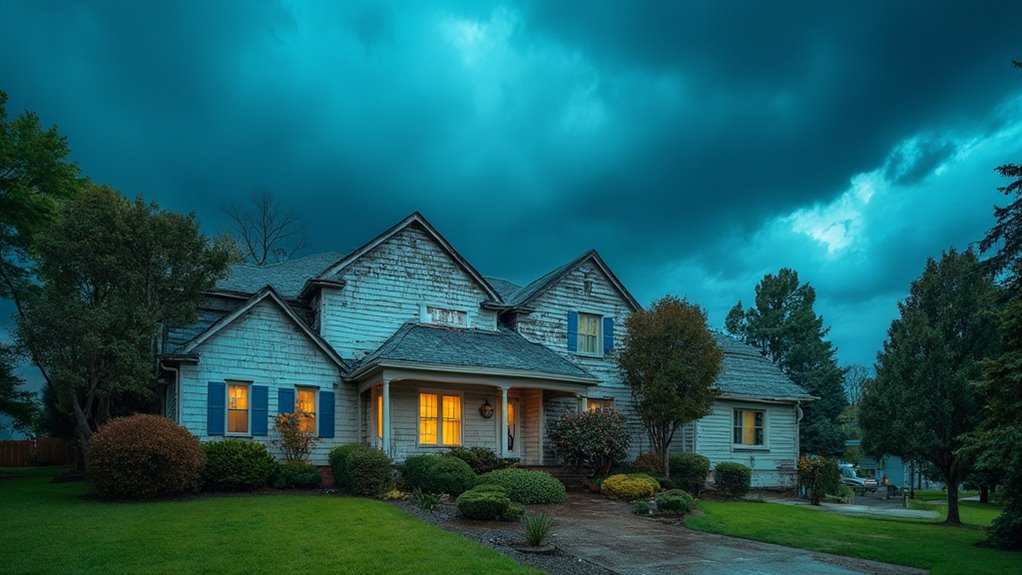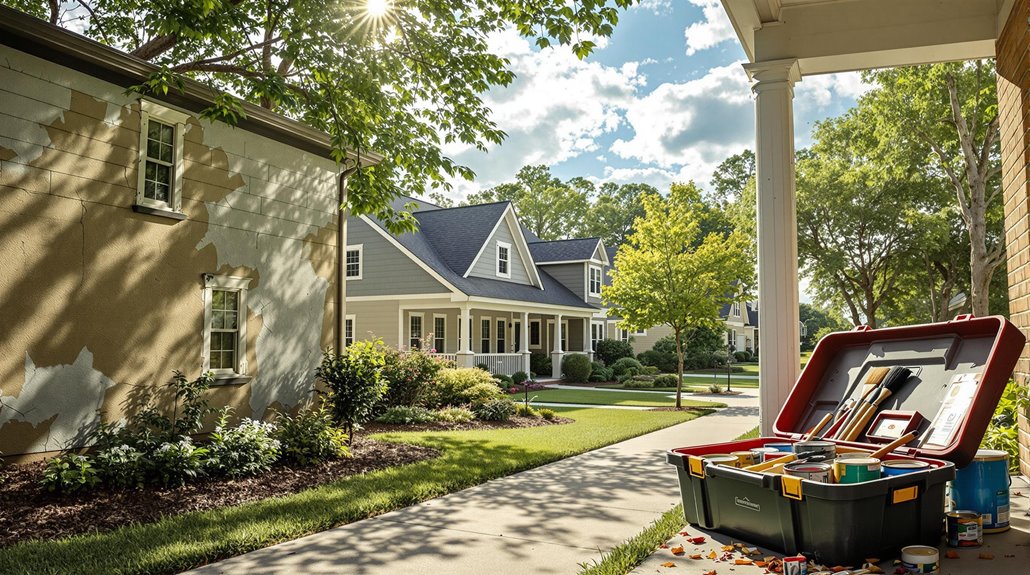Georgia's variable weather can challenge your home's stability, especially in Smyrna. Summer heat strains cooling systems, while heavy spring rains and potential flooding can compromise foundations. Winter poses risks with frozen pipes and heavy snow loads on roofs. To boost resilience, regularly inspect your home systems and verify adequate insulation. Seal gaps around windows and doors to improve energy efficiency and reduce costs. Maintain your outdoor areas by pruning dead tree limbs and clearing gutters. Developing an emergency plan for severe weather can further protect your home. Investigate additional strategies to stay ahead of these challenges.
Key Takeaways
- Assess your home's insulation, especially in attics, to enhance energy efficiency and combat Georgia's high summer temperatures.
- Regularly inspect and maintain HVAC systems to ensure effectiveness during hot summers and variable winter temperatures in Smyrna.
- Prune dead or diseased tree limbs to prevent damage from falling debris during winter storms and high winds.
- Winterize your home by sealing gaps around windows and doors, applying weather stripping, and draining irrigation systems to prevent water damage.
- Create a family disaster plan addressing local hazards like floods and hurricanes, including emergency kits and communication strategies.
Understanding Georgia's Weather Patterns

When you consider living in Smyrna, it's vital to grasp Georgia's humid subtropical climate, which shapes your environment throughout the year. This climate features notable seasonal fluctuations that can markedly affect your home. Summers are long, hot, and humid, with daytime temperatures often soaring above 95°F, particularly in July and August. The humidity effects during this period can lead to increased mold growth and strain on your HVAC systems, making proper ventilation indispensable. Additionally, average afternoon temperatures during the summer months hover near 90°F, further intensifying the need for effective cooling solutions. To combat moisture issues, water removal services are essential in safeguarding your home against potential damage.
As spring arrives, you'll experience variable weather, with temperatures swinging between 40°F and 75°F, and April often being the rainiest month. These fluctuations necessitate robust drainage systems to handle sudden downpours. Autumn brings cooler, drier air, but September and October can still produce warm days, which may lead to potential HVAC challenges.
Winter, while milder with temperatures in the mid-50s, can still introduce cold snaps, particularly in the northern regions. Understanding these patterns allows you to proactively prepare your home against moisture accumulation and temperature extremes. By mastering these weather dynamics, you'll improve your home's resilience against Georgia's unique climate challenges.
Impact of Winter Weather on Homes
Winter weather poses significant risks to your home's structural integrity and energy efficiency. As temperatures drop, frozen soil can compromise your foundation, while the weight of accumulated snow may threaten your roof's stability. It's crucial to address these concerns proactively to maintain both safety and comfort in your home. Additionally, immediate action in response to any water damage can prevent further deterioration and costly repairs.
Structural Damage Risks
Many homeowners underestimate the structural damage risks posed by winter weather, but the consequences can be severe. Heavy snow accumulation can increase your roof's load by up to 30 times, risking collapse. To maintain roof integrity, guarantee proper attic insulation and ventilation to minimize the freeze/thaw cycle that causes ice dams, which can lead to interior water damage.
Furthermore, high winds can dislodge shingles, exposing your home to further damage. You should routinely inspect trees around your property, especially dead or diseased limbs that could snap under the weight of snow or ice. Pruning these branches preemptively can protect your home from falling debris.
Pipe protection is likewise critical during winter. Extreme cold can freeze both interior and exterior pipes, leading to costly repairs. Detaching garden hoses and winterizing irrigation systems are vital steps. Leave faucets dripping slightly and open cabinet doors under sinks to keep warm air circulating around pipes.
Energy Efficiency Concerns
As temperatures drop, energy efficiency becomes a critical concern for homeowners in Smyrna. To maximize comfort and minimize costs, you should consider conducting energy audits to identify where your home is losing heat.
| Action | Potential Cost Savings |
|---|---|
| Seal gaps around windows/doors | Up to 10% on energy bills |
| Optimize heating system | 3-4% for each degree lower set |
| Use energy-efficient LED bulbs | 75% less energy than incandescents |
Start by inspecting doors and windows for gaps, then seal them with weatherstripping or caulk. Check areas like attic hatches and outlets to eliminate air leaks. Adjust your thermostat to 68 degrees or lower, and consider using programmable thermostats for greater control.
Utilizing natural sunlight can further improve your home's energy efficiency—open blinds during the day to let warmth in. Finally, replacing cracked caulk can prevent significant energy loss. By implementing these strategies, you'll not only enhance your home's comfort but likewise achieve substantial cost savings over the winter months.
Essential Winter Preparation Tips

Preparing your home for the cold months ahead is vital to guarantee comfort and safety. To achieve ideal winter readiness, start with insulation. Confirm your home is well-insulated, and apply weather stripping around doors and window sills to eliminate drafts. Drain your lawn-irrigation systems to prevent damage from freezing.
When it comes to plumbing precautions, disconnect outdoor hoses and cover outside water fixtures to protect against freezing temperatures. During colder months, allow faucets to drip slightly to reduce the risk of pipe freezing, and open cabinet doors to circulate heat around uninsulated pipes. Insulate any pipes located in unheated areas like the garage or basement, and familiarize yourself with the location of the main water shutoff valve.
Regular maintenance of your heating system is vital. Schedule a tune-up to confirm efficiency and safety. If you use a wood-burning fireplace, clean and inspect the chimney annually. In case of power outages, have flashlights ready and steer clear of candles to reduce fire risks. By following these vital winter preparation tips, you'll safeguard your home against the challenges of the season.
Travel Safety During Severe Weather
Traveling during severe weather can pose significant risks, so it's crucial to take proper precautions. Before you head out, always check current road conditions and traffic updates. Plan your route meticulously and identify alternative paths in case of road closures. It's wise to stock your vehicle with an emergency kit that includes a charged cell phone, flares, and basic tools.
When driving in severe weather, maintain a slow speed and increase your following distance, especially on wet or slick roads. Never attempt to drive through flooded areas; even 12 inches of rushing water can carry away most vehicles. Stay alert for pedestrians and cyclists, particularly in poor visibility conditions.
During severe thunderstorms or tornado warnings, find shelter in a substantial building rather than risking travel. If a tornado approaches, don't try to outrun it; instead, seek a safe location or drive out of the tornado's path if possible. By remaining informed through local emergency services and having a well-prepared emergency kit, you can improve your safety on the road during severe weather events.
Dealing With Power Outages

When a power outage occurs, being prepared can make a significant difference in your comfort and safety. Start by assembling an emergency kit with non-perishable food, water, necessary medications, flashlights, batteries, and a manual can opener. This kit guarantees you have necessities on hand during outages.
To improve your home's resilience, inspect for drafts and seal any gaps to retain heat. If you rely on alternative heating options like fireplaces or wood stoves, verify they're cleaned and inspected before winter. During an outage, keep refrigerator and freezer doors closed; a full freezer can keep food safe for up to 48 hours without power.
Stay informed through multiple channels, including NOAA weather radios and smartphone apps, to receive updates on severe weather. Conserve heat by keeping doors and windows closed, using layers of clothing, and blankets. Always prioritize safety by using flashlights instead of candles to reduce fire hazards, and place generators outdoors to prevent carbon monoxide poisoning.
For power restoration, report outages promptly through the Georgia Power website or their mobile app to expedite recovery efforts. Make certain your family knows the emergency plan, guaranteeing everyone stays connected and informed.
Home Maintenance for Resilience
To improve your home's resilience, focus on effective insulation and sealing techniques that prevent air leaks and increase energy efficiency. Establish a regular maintenance schedule to inspect and address potential issues before they escalate, ensuring your home stays protected year-round. By prioritizing these elements, you'll bolster your home's defenses against extreme weather conditions and reduce energy costs.
Insulation and Sealing Techniques
Effective insulation and sealing techniques are critical for enhancing your home's resilience against the elements. By employing the right insulation types and sealing methods, you'll not only improve energy efficiency but likewise protect your home from moisture and drafts.
| Insulation Type | Application Area |
|---|---|
| Attic Insulation | Between and over joists, access doors |
| Exterior Wall Insulation | Wall cavities, foundation walls |
| Floor and Slab Insulation | Above vented crawl spaces, slab floors |
Start by installing high-density R-30 batts in the attic and using blow-in insulation for hard-to-reach areas. For exterior walls, consider injectable spray foam or wet spray cellulose. When sealing, apply silicone sealant around windows and doors to prevent cold drafts. Weatherstripping around movable components guarantees a snug fit, while caulk effectively seals joints and gaps.
Lastly, don't overlook basements. Protect against moisture by sealing lower areas and using waterproof sealant in bathrooms. These insulation types and sealing techniques are crucial for maintaining a comfortable, energy-efficient home in Smyrna.
Regular Maintenance Schedule
Maintaining your home is vital for guaranteeing its longevity and resilience against the elements. To achieve this, establish a regular maintenance schedule that includes seasonal checklists and routine inspections. Start with exterior and yard maintenance. Clear dead plants and trim overhanging branches to prevent damage. Inspect your fence and deck for wood rot, and address any issues promptly.
For your roof and gutters, clean them regularly to guarantee proper water drainage. Check for missing shingles and repair any leaks to avoid water intrusion. Don't overlook plumbing; inspect toilets, faucets, and water heaters for leaks and proper operation.
In terms of HVAC and interior maintenance, clean or replace furnace filters to improve air quality. Regularly check the operation of windows and doors, confirming they're sealed correctly.
Create a thorough checklist for each season, focusing on specific tasks that protect your home from Georgia's varied weather. By committing to these routine inspections and maintenance tasks, you'll safeguard your investment and guarantee your home remains resilient against the elements.
Long-Term Climate Considerations

Sustainability in Smyrna requires a keen awareness of long-term climate considerations that can greatly impact the community. As you navigate climate projections, focus on flood resilience strategies to mitigate the risks posed by rising sea levels, increased flooding, and rising temperatures.
| Climate Factor | Implications for Smyrna |
|---|---|
| Sea Level Rise | 1-4 feet rise in the next century; increased coastal flooding. |
| Heavy Rainfall | 27% increase in precipitation; growing flood risk in inland areas. |
| Rising Temperatures | 17-43 days/year above 95°F; impacts on health and agriculture. |
| Water Resources | 10-50% increase in water demand; heightened drought risks. |
| Ecosystem Impacts | Reduced water levels affecting local ecosystems and recreational activities. |
The rising sea levels and heavier rainfall patterns amplify the risk of property damage. You should consider investing in flood-resistant materials and designs for your home. Moreover, as temperatures rise, make certain your landscaping incorporates drought-resistant plants to maintain soil moisture. Being proactive about these long-term climate considerations will improve both your property's resilience and the sustainability of the Smyrna community.
Emergency Planning and Response
A thorough emergency plan is crucial for Smyrna residents to effectively navigate the challenges posed by natural disasters. Start by identifying potential hazards such as floods, hurricanes, and tornadoes. Create a family disaster plan that includes designated evacuation routes and a clear disaster communication strategy. This guarantees everyone knows how to get in touch during a crisis.
Sign up for emergency alerts through your county's opt-in system to receive timely updates. Familiarize yourself with local warning signals and keep a NOAA weather radio for real-time information. Regularly practice emergency drills to reinforce your family's preparedness, making certain everyone understands their roles and responsibilities.
Know your emergency resources, including safe shelters and utility cutoffs. Assemble an emergency kit stocked with necessities and verify it's easily accessible. After a disaster, implement your emergency plan by evaluating damages carefully. Document everything for insurance purposes and prioritize safety before re-entering your home.
Conclusion
In Georgia, weather can be unpredictable, but your home's resilience doesn't have to be. By preparing for winter's chill and maintaining your property, you can safeguard against potential damage. Remember, a proactive approach leads to peace of mind, turning challenges into manageable tasks. So, equip yourself with knowledge, stay vigilant, and act decisively. After all, it's not just about surviving the storms; it's about thriving in their aftermath. Your home deserves that commitment.







